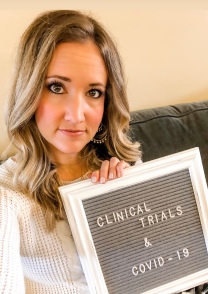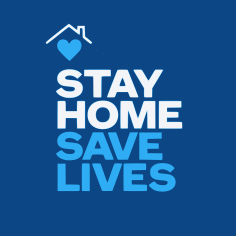They say there’s a first for everything and that was the case for me with telehealth visits. Nearly 15 years into my patient journey with Crohn’s disease, and I had never had a video chat with a physician. Going into the experience felt a bit daunting, a little uncomfortable. As patients, we get so used to our routine for managing our illness, that changing the course of care can make us feel anxious. I know I’m in the majority when it comes to being new to this whole telemedicine thing. Let me tell you, I really loved it. I walked away from my computer smiling and feeling happy. Here’s why.
Connecting over video saved me time and a whole lotta energy
My commute to and from my GI office is about 35 minutes and usually involves bringing at least one of my kids with me or coordinating childcare. It was awesome to just walk into my kitchen and instantly connect with my physician. We’ve talked on the phone many times in the past when I have a question or an issue but conversing over video made a big difference. You feel much more connected and like you’re sitting in the same room.
I didn’t feel rushed
Oftentimes while in the examining room, I feel like I’m racing the clock to get all my questions asked. It can feel like I’m just one of many appointments in a row and that my physician is bouncing from room to room. There was a sense of calm and a laid-back aspect of the call that sat well with me. It felt like a 35-minute heart-to-heart that was genuine, educational, and comforting. I felt listened to and heard. We talked about everything from my Crohn’s symptoms to my next colonoscopy, and how to handle everything with the COVID-19 pandemic.
We set a game plan in place
Something I love about my GI is that she’s extremely proactive and aggressive. You ask her a question and she immediately has a confident response. I’ve been more symptomatic the past few weeks than I have been for awhile, so she ordered a fecal calprotectin test to see if there was any inflammation going on. My husband, Bobby, picked up the test from the lab and I will bring the completed test in when I get my bloodwork this week. As far as my annual colonoscopy for later this summer, she told me that we should be ok to get the scope in, as that’s an ideal window for when things are expected to calm down COVID-wise. If we waited or delayed the scope, she fears it could be a YEAR until we’re able to do one again. 
She determined that part of the reason I may be experiencing more abdominal pain is unintentionally changing up my diet. Something so many of us are doing right now. Our family hasn’t had take-out food since March 12th. While it’s great to have a healthier diet, having less processed foods can make things more challenging on our digestive systems. She recommended I incorporate more carbs into my daily diet, drink more water from a cup vs. a straw or a bottle (as that can cause gas to build up), and even try drinking peppermint tea or having peppermint oil in the air.
Guidance for navigating the pandemic and IBD
I asked my GI about her recommendations for what to do once Stay at Home orders are lifted and how long social distancing should be in place as someone who is immunocompromised from my medication. She said I am free to go to public parks and trails (while wearing a mask) but should stay out of everything from supermarkets to shopping malls through the summer. She advised it would be best to have my husband continue to run our necessary errands while wearing a mask. She’s anticipating a second peak of the virus will happen when the colder weather approaches.
Luckily, Bobby has been able to work from home since March 18th, a benefit of corporate America. When I asked about what to do when he has to go back in the office, she said he would need to wear a mask and at the sign of any symptoms, would need to stay away from our family.
As far as flaring and needing to go to the hospital, my GI recommended keeping her in the loop and openly communicating about symptoms so we can handle as much as we can outpatient. If there is an acute issue (fever, vomiting, etc.—things that happen with an obstruction), then I should go to the hospital as I normally would.
When it comes to IBD patients being tested with an antibody test, she doesn’t foresee that happening unless we are about to go into surgery or have a procedure. Even then, she says our immune response is different than that of the rest of the population.
Recommendations to keep in mind ahead of your telehealth appointments
Come prepared. Have questions. Be open about your symptoms and don’t downplay anything. Your physician can only help you if they know what’s going on.
Familiarize yourself with the technology. I choose to do my call on the computer, much like a Zoom meeting, but through the patient program provided by my office. There was also an option to click a link in a text message and chat like you’re on FaceTime. 
Try to have a quiet space for your call where you can focus. Unfortunately, my husband had a work call during my appointment, but I was able to put the baby down for a nap and bribe my 3-year-old with some snacks and TV. He only interrupted a couple of times, but my physician understood and we had a good laugh about how fruit snacks work wonders to calm or distract toddlers.
Ask about billing. Telehealth appointments at my doctor’s office are billed the same as a routine appointment. Make sure your office has your insurance information ahead of time.
Listen to this About IBD podcast from one of my favorite patient advocates, Amber Tresca, and one of the top IBD docs, Dr. Nandi, about how to best prepare for telehealth appointments during the pandemic.



 Also, surround your workspace with all that you may need during the day. Computer, chargers, phone, etc. I like to also put candles or fresh flowers near my workspace – they smell great and elevate my mood. With spring finally here, go outside and pick a few flowers and put them in a mason jar. Anything that makes you smile and motivates you.
Also, surround your workspace with all that you may need during the day. Computer, chargers, phone, etc. I like to also put candles or fresh flowers near my workspace – they smell great and elevate my mood. With spring finally here, go outside and pick a few flowers and put them in a mason jar. Anything that makes you smile and motivates you. It’s extremely important to incorporate self-care into your routine right now. There’s so much uncertainty and doom/gloom in the news. Make sure you are taking time to appreciate yourself, your team, and your family, while keeping your health as a top a priority.
It’s extremely important to incorporate self-care into your routine right now. There’s so much uncertainty and doom/gloom in the news. Make sure you are taking time to appreciate yourself, your team, and your family, while keeping your health as a top a priority.
 Right before COVID-19 started wreaking havoc in the States. Before Guy was born, Suzy’s biggest fear was a postpartum flare. After the birth of her second oldest daughter, Alice, she had the worst Crohn’s flare of her life and was hospitalized.
Right before COVID-19 started wreaking havoc in the States. Before Guy was born, Suzy’s biggest fear was a postpartum flare. After the birth of her second oldest daughter, Alice, she had the worst Crohn’s flare of her life and was hospitalized. 
 Unfortunately, when I was put on prednisone last summer, I developed extremely high eye pressures. I was diagnosed as “Glaucoma suspect” at 40 years old, meaning I have some risk of the disease, but no proven damage (yet), so my eyes are monitored often.
Unfortunately, when I was put on prednisone last summer, I developed extremely high eye pressures. I was diagnosed as “Glaucoma suspect” at 40 years old, meaning I have some risk of the disease, but no proven damage (yet), so my eyes are monitored often. As a woman and a mom of three who has battled Crohn’s since 2008, I believe if it’s your dream to have children, or a family, you should most definitely pursue that. Consult with your GI and OB doctors prior to getting pregnant, and make sure you’re in remission. Pregnancy can be challenging, but if you’re also flaring, it’s that much harder.
As a woman and a mom of three who has battled Crohn’s since 2008, I believe if it’s your dream to have children, or a family, you should most definitely pursue that. Consult with your GI and OB doctors prior to getting pregnant, and make sure you’re in remission. Pregnancy can be challenging, but if you’re also flaring, it’s that much harder.




